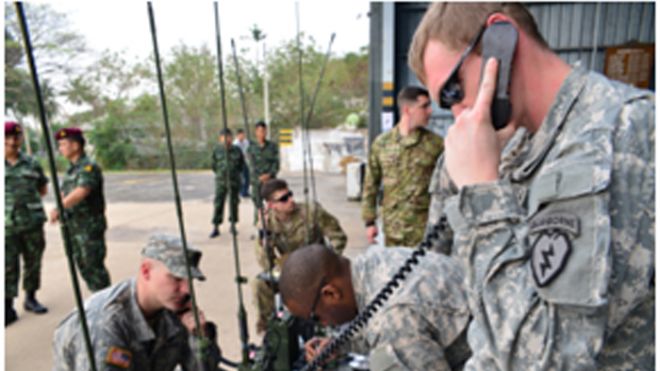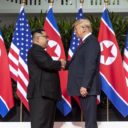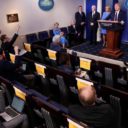

The C-17 Globemaster III aircraft carried approximately 400 U.S. military and Royal Thai Armed forces directly from Alaska to jump into Thailand as part of Exercise Cobra Gold 14, an annual Thai-U.S. co-sponsored joint and multinational exercise. (Photo by Sgt. 1st Class Crista Mary Mack, U.S. Army)
This past weekend, the first U.S. military boots hit central Thailand soil to kick off the official change in military and foreign policy, known as the Asia pivot. Experts say the move was undoubtedly aimed to flex military muscle at Beijing, an show of U.S. power projection amid China developing ballistic missiles designed to destroy the U.S.-Pacific fleet.
As part of the annual multinational joint exercise dubbed Cobra Gold, a U.S. airborne unit drill executed a jump to seize and secure an airfield at Lop Buri, which is 90 miles north of Bangkok, simulating U.S. military responses to a humanitarian disaster. The exercise involved 400 parachutists from 4th Brigade Combat Team (Airborne), 25th Infantry Division, which is based at Fort Richardson outside of Anchorage, Alaska.
The decision to co-execute military drills in the Pacific with Thailand as part of the Asia Pivot, was no accident. The presence of U.S. troops on the ground, particularly in Thailand which China views as their backyard and has clashed with on a series of instances over the decades, will be unacceptable for Beijing. The communist-led PRC, or People’s Republican of China, absolutely resents America’s 60-year dominance in the Asia-Pacific region, specifically our involvement with Thailand, the Korean Peninsula and Japan.
“It’s a powerful message that the U.S. is putting boots on the ground because they have the entire U.S. military standing behind them. Every country in the region recognizes that,” said retired General Jack Keane, a national security analyst and former acting U.S. Army chief of staff. The move was also meant to calm U.S. regional allies and demonstrate a commitment to their security.
“We’ve put parachuting forces into places and taken an amount of risk before and the U.S. will continue to do that,” Keane added.
Ironically, the Chinese are actually participating in the eight-nation exercise for the first time this year, and the invitation is outrightly viewed to be a token gesture toward the regional power that the exercises are aimed at. Before Cobra Gold began, a Chinese military official arrogantly stated while talking to the state-run media that Beijing’s “regional military impact cannot be ignored.”
And in truth, the U.S. is concerned over decisions by Beijing to drastically ramp up defense spending, which is increasing at 10 percent every year. China has been developing an anti-ship ballistic missile (ASBM) — known as the “Carrier Killer” — that can strike U.S. aircraft carriers and other vessels at a range of 1,200 miles (2,000 kilometers).
It is estimated that the missile can travel at Mach 10 (4-5km/sec) and reach its maximum range in less than 12 minutes.
Because the U.S. has not yet addressed the systems necessary to combat the “Carrier Killers” developed by the Chinese, though Congress is now working on a bipartisan proposal for a rapid development of new military systems to intercept the ASBMs, the Asian Pivot is relying upon the 4-25 to begin the Pacific projection.
“This mission in Thailand is the very start of that,” said LTC, Alan Brown, spokesman for U.S. Army, Alaska. “4-25 helps spearhead the combat readiness for America’s new Asia posture because their geographic reach extends more than any other over such diverse and extreme terrain and weather conditions.”
The brigade can deploy infantry soldiers anywhere in the region within 19 hours from “the phone call to being on the ground.” It is supported by a Stryker brigade, whose tactical vehicles can be flown in to bolster the advance forces within two to four days.
In military parlance, its combat readiness is considered part of America’s standard battle rhythm. And, as the brigade’s additional training with their Thai colleagues is intended to show this weekend, it doesn’t mean that America would need to enter into a fight in the Asia-Pacific on its own.
“If we do get into some kind of conflict or rapid engagement in the Asia-Pacific,” added Brown, ”then the U.S. is going to do it in full lockstep with its partner nations.”
It was a cold exercise between the two countries, indeed. The Chinese send just 17 observers during Cobra Gold, while the U.S. sent 9,000.







